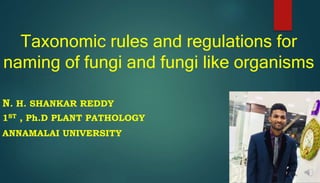
Taxonomic rules and regulations for naming of fungi
- 1. Taxonomic rules and regulations for naming of fungi and fungi like organisms N. H. SHANKAR REDDY 1ST , Ph.D PLANT PATHOLOGY ANNAMALAI UNIVERSITY
- 2. • Taxonomy is a part of biological science which deals with the study of naming and classification of organisms • The nomenclature is the branch of systematics that determines the correct scientific name for taxon. The naming of fungi was previously governed by International Code of Botanical Nomenclature (ICBN). Each fungus has unique scientific name that indicates its taxonomic placement among other organisms. The scientific names are Latin names assignee to particular fungus based on binomial system of nomenclature of to identify organisms throughout the world. The first part is binomial name is the genus and the second is the Specific species the genus and species have no fixed endings. The genus name maybe common to several species, but the combination applies to only one species in the entire system of classification.
- 3. Presently nomenclature codes govern the naming of: 1. Algae, Fungi and Plants– International Code of Nomenclature for algae, fungi, and plants (ICN), which in July 2011 replaced the International Code of Botanical Nomenclature (ICBN) and the earlier International Rules of Botanical Nomenclature. 2. Animals – International Code of Zoological Nomenclature (ICZN) 3. Bacteria and Archaea– International Code of Nomenclature of Prokaryotes (ICNP), which in 2008 replaced the International Code of Nomenclature of Bacteria (ICNB) 4. Viruses – The International Code of Virus Classification and Nomenclature (ICVCN)
- 4. Carolus van Linnaeus • Father of Taxonomy • Eructed “binominal system of nomenclature” • Grouped the living thing into hierarchical categories • Introduced seven level of classification
- 5. Seven level of classification Kingdom Phylum Class Order Family Genus Species
- 6. The rules of writing scientific names • Binomial system – Use two names, generic name and species name. the genus and species have no fixed endings • Trinomial nomenclature – Add a third name to the binomial to provide further information of the organism (eg – forma specialis, race, pathovar) • Author’s name – Place the name of the taxonomists who were the first person who gave the names to given organism and the end of the binomial, and abbreviate
- 7. Guidelines for writing scientific names • Capitalize first letter of generic name, while the rest, including whole of species, in a small cases. Leave a single space between genus name and species name. in case where the author’s name is to be included use standard abbreviation for the author name. • Use Italics for genus name and species name, but not the author name, in hand written manuscript, or when use a type writer with no Italics, underline that are to be italicized. Name lower the species level are to be treated in the same way as the binomial, i.e. italicized note that the whole subspecies, forma specials, race, variety, etc. which are abbreviated are not italicized • Eg – Fusarium oxysporum f.sp. vasinfectum (G.F.A tk) W.C. Synder & H. N. Hansen
- 8. According to the International Code of Botanical nomenclature (ICBN), the following ‘suffixes’ are used for phyla and other categories of a fungal taxon Phylum mycota Sub phylum mycotina Class mycetes Subclass mycetidae Order ales Family aceae Phylum Basidiomycota Sub phylum Basidiomycotina Class puccinioycetes Subclass Puccinioycetidae Order Pucciniales Family Pucciniaceae Example - Taxonomic classification of wheat stem rust
- 9. Types and Nomenclature Holotype – The single specimen or illustration that the author(s) clearly indicated to be the nomenclatural type of a name. Lectotype –A specimen or illustration designated from the original material as the nomenclatural type when there was no holotype specified or the holotype has been lost or destroyed. Isotype – A duplicate of the holotype. Syntype – Any specimen (or illustration) cited in the original description when there is no holotype, or any one of two or more specimens simultaneously designated as types.
- 10. Paratype – Any specimen (or illustration) cited in the original description that is not the holotype nor an isotype, nor one of the syntypes. Neotype – A specimen or illustration selected to serve as nomenclatural type if no material from the original description is available. Epitype – A specimen or illustration selected to serve as an interpretative type, usually when another kind of type does not show the critical features needed for identification.
